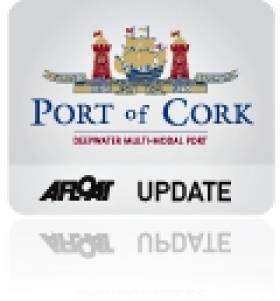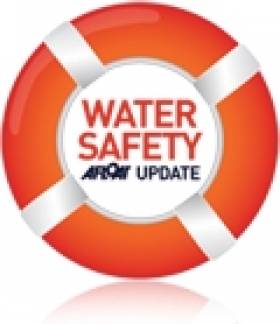Displaying items by tag: Maritime TV Programmes
#€40thousandEgg! - In the penultimate episode of 'The Local Eye', The Donegal Post team visit a luxury five star cruise ship docked in Killybegs but can boss Chris keep social diarist Gabrielle away from duty free long enough to get the story?
And will the €40,000 Faberge Egg they find go onto Gabrielle’s Christmas List?
To find out more about the expensive egg!... watch The Local Eye, it's on tomorrow night, Thursday, December 22nd on RTÉ One at 7pm
Killybegs continues to develop the cruise business which is a relatively new sector that has attracted famous lines. Among them Holland America Line (HAL) which called in September (see report's photo) followed by next port of call 'albeit' anchorage in Galway Bay.
The cruiseship calls to Killybegs will be given another boost given Cunard's announcement to deploy both 'Vista' class sisters in 2018. The sisters are the 90,000 tonnes Queen Elizabeth and Queen Victoria.
The north-west port has relied heavily on the more traditional fishing industry which was followed by that of the energy and exploration sectors.
Save The Date: Shannon-Erne Waterway To Feature On TV's 'Great Canal Journeys' On 8 November
#InlandWaters - The waters of the Lough Allen canal, Lough Erne and the Shannon-Erne Waterway will feature in the new series of Channel 4's Great Canal Journeys.
Presenters Tim West and Prunella Scales filmed in the area in July 2015, beginning their journey in Drumshanbo, and between music sessions, poetry and hyrdoelectric locks, they tried everything on the trip up the canal and out onto Lough Erne where they visited islands, homes and castles.
The series starts this coming Sunday (25 October), and the Irish episode will be broadcast at 8pm on Sunday 8 November on Channel 4, with catch-up available later via the channel's on-demand service All4.
'Living the Wildlife' Returns Tonight On RTÉ One
#OnTV - Living the Wildlife returns to our screens tonight (Tuesday 24 March) on RTÉ One with a look at the "dive-bombing" great skuas of Inishark, one of the bounty of species along the Connemara coast.
Among those celebrating the new series are the Irish Whale and Dolphin Group, which previously worked closely with presenter Colin Stafford-Johnson in filming the fin whales and humpback whales that frequent West Cork each year, among others.
Some of this same marine wildlife is bound to pop up in John Creedon's own upcoming series hailing the wonders of the Wild Atlantic Way, as previously reported on Afloat.ie.
#OnTheTV – Building Ireland, the first of a new television series starts tonight on RTE 1 (7pm) which explores and explains how Ireland's great building and engineering achievements came to be, and their impact on the development of our towns and cities.
In the second episode, (next week on 15 July), a look at 'The Banking Halls of Dame Street', engineer Tim Joyce is setting out to discover how an odd, metal structure on Sir John Rogerson's Quay, played a crucial role in building the foundations of modern Dublin 140 years ago the docklands were in need of a radical overhaul, just to keep up trade demands of the British Empire.
An Irish engineer from Clareen, Co Offaly - Bindon Blood Stoney – was pioneering new methods in port construction. But the finest Victorian engineers of the day said his proposed plans for Dublin port just wouldn't work.
Would Blood Stoney's new innovation of a diving bell and shear crane work?
For a sneak preview CLICK HERE, of the series which is also to be presented by architect, Orla Murphy and geographer Susan Hegarty.
On the TV: ‘Ade to Sea’ Explores Manchester Ship Canal, Liverpool Docks and Giant Welsh Wind Farm
#OnTV – It may be the final episode of 'Ade to Sea' (tomorrow, Thursday on UTV at 8.30pm) however England's North West and notably the Manchester Ship Canal are to feature topics, among them those previously covered on Afloat.ie, writes Jehan Ashmore.
Asides the Guinness ships that once crossed the Irish Sea, the Manchester Ship Canal for example is where currently Kelloggs cereals are carried on the Coastal Deniz, a sister of containership Arslan II (formerly Coastal Isle) and having grounded off Arklow Bank in January. Following dry-docking in Dublin Port, Arslan II arrived in Turkish waters earlier this month.
Both sisters in recent years operated Coastal Container Line's Liverpool-Dublin service, in which the Peel Ports Group (owners of Liverpool Port) still operate the MTL container facility located beside the Poolbeg Yacht and Boat Club's marina. The Liffey-Mersey service is now run by BG Freightline.
Ade to Sea is presented by the comedian, Ade Edmondson, who over the last six episodes has set out to sail and explore Britain's maritime past and present and tomorrow night's broadcast, will see him head down the River Mersey to Liverpool.
The north western English port in the early 19th century represented forty per cent of the world's trade, and made Liverpool the busiest and most advanced port in the entire world. The present day port is undergoing a major development of a new riverside container terminal named Liverpool2.
Ade starts his journey at Eastham where the Manchester Ship Canal connects with the River Mersey. The ship canal transformed Manchester from a landlocked city into the third busiest port in Britain.
Also Ade explores the vital role of the tugboat, which towed large cargo ships up the narrow and shallow waters. He meets three generations of one family who run the tugboat business on the ship canal today and joins them as they tow a three thousand ton container vessel (the Coastal Deniz as pictured above) down the historic waterway.
Once back in Liverpool, Ade boards a triple masted topsail schooner, the Kathleen and May in which Afloat.ie has reported on. Tall ships like these made transatlantic journeys during 1800s.
Ade joins Scouser, Hughie Jones at sea to learn about how shanties or working songs were sung on the old boats that sailed out of Liverpool.
To learn more about what's happening off the north-west coast today Ade travels out eleven miles to sea where they're in the middle of building one of the largest wind farms in the world, Gwynt Y Mor.
The new wind-powered electricity generating facility is serviced by support vessels from Mostyn and offshore of Rhyl is the wind-farm's very own floating accommodation vessel, the Wind Solution.
For the last two years hundreds of people have been involved in preparing for one hundred and sixty wind turbines to be installed. Ade joins the men and women working on the wind farm overnight to get a rare insight into what it's like to work and live at sea.
Cork's 'Mega Port' Features In New TV3 Documentary
#PortOfCork - Have you ever wondered about the functions of the Port of Cork, the kind of people who work there, what they do and how many ships visit Cork every day and the types of cargo on board?
You can find out when you tune in to new 'fly on the wall' TV documentary series Cork Mega Port on TV3 starting Monday 28 April at 9pm.
Goldhawk Media produced the series of four hour-long episodes over four months spent living and breathing the Port of Cork.
The documentary crew followed all port employees including management, crane drivers, tug operators, pilots, launch crew and maintenance and engineering staff. Regardless of weather, they have been out on the sometimes high seas, filming the likes of Panamax-size vessels laden with cargo arriving into the port.
The series promises to give an exciting insight not just into the everyday operations of the port and the people behind it, but also highlights its importance to the region and necessity as a gateway for trade both in and out of Munster.
As well as having a serious side, the series will show the lighter side of the port by following some of the characters who have worked there for many years.
The Port of Cork prides itself on having a reliable, long-serving, experienced group of employees, and one thing that is evident within the series is the passion that exists in working at the Port of Cork.
Some staff describe working at the Port of Cork as having the "best job in the world" and from the varied services and operations that the port is involved in, it’s easy to see why.
Speaking about the new series, Port of Cork chief executive Brendan Keating said: “When we were approached by Goldhawk Media on behalf of TV3 back in 2013 and heard their experience and saw their enthusiasm, we jumped at the opportunity to get involved in this production.
"While the series shows everything the port is involved with from operations, to maintenance, the cruise business, community initiatives and our recent port redevelopment plans, it has been the level of enthusiasm from staff which has really shone through and we are very proud to share this with the people of Ireland.”
Cork Mega Port will air over four weeks on TV3 from Monday 28 April at 9pm.
Irish Teens Begin 'Blue Zoo' Filming In Australia
#OnTV - Four Irish teenagers are currently having the time of their lives filming a new marine wildlife documentary series in Australia, according to RTÉ's The Entertainment Network.
As previously reported on Afloat.ie, Blue Zoo will follow the exploits of the four Irish young people teaming up with four Australian teens to work with rescued dolphins, seals and turtles at a marine wildlife park in Coffs Harbour, New South Wales.
Aurea Kenny, Sophie O'Loughlin-Kennedy, Tallann Maguire and Darragh Joyce will spend the next six weeks with their Aussie counterparts training with and caring for wildlife, and filming for the show - which will be broadcast on RTÉ Two and Australia's ABC3 next year.
RTÉ TEN has more on the story HERE.
Irish Wildlife Showcased In New BBC TV Production
#OnTV - Footage of fin whales filmed by the BBC off the coast of Ireland in November 2012 is set to feature prominently in a new TV series called The Great British Year.
The programme, which airs on BBC One at 9pm on Wednesdays until 23 October (repeated Sunday afternoons at 4:50pm) documents the nature of the British Isles through the seasons.
The whale footage, filmed with West Cork-based whale watch operator Colin Barnes of Cork Whale Watch, will feature in the last programme of the series on Wednesday 23 October.
“It’s great to see Irish wildlife showcased in this way,” said Calvin Jones, founder and managing editor of Ireland’s Wildlife. “We have some amazing wildlife here in Ireland, and I believe there’s real potential to develop wildlife tourism in a sustainable and informed way that will benefit both local communities and wildlife.
"Whale watching is an important part of that. Many people don’t realise that Ireland is one of Europe’s whale and dolphin hotspots. Almost a third of all cetacean species have been recorded in Irish waters, and some, including fin whales and humpback whales, are regular visitors to our coasts.
“Autumn and early winter - so from early October to about the end of December - is peak large whale season off the south west coast, and offers fantastic opportunities to get out and see these amazing creatures first hand,” he added.
Fin whales are the second largest animal on earth - only blue whales grow bigger. Every year they visit Ireland’s south coast in numbers to feed on the large shoals of herring that gather there.
New TV Series Unveils 'Secret Life of the Shannon'
#OnTV - Sunday 26 May sees the first of a two-part documentary series on The Secret Life of the Shannon on RTÉ One.
The series will take viewers on a journey along the River Shannon with wildlife cameraman and presenter Colin Stafford Johnson, who spent a year living on the river on a barge, camping on its banks and exploring its tributaries in a traditional canoe.
His quest was to film the natural history of the 340km of the Ireland's longest inland waterway as it has never been seen before - and if the above video is anything to go by, he's done an incredible job.
The Secret Life of the Shannon part of the RTÉ Goes Wild month-long celebration of Ireland's wildlife on television, radio and online.
Episode one will be broadcast on Sunday 26 May at 6.30pm on RTÉ One, with the second episode to follow at the same time on Sunday 2 June.
NI Lifeguards To Feature In New TV Series
#WaterSafety - RNLI lifeguards in Northern Ireland are to feature on a new television series on UTV.
The Magazine starts on Sunday 7 April at 7.30pm with host Sarah Travers in her home town of Portstewart to introduce viewers to some of her favourite people, places and topics.
As part of the first programme, TV presenter Emma-Rosa Dias will find out what it takes to be a lifeguard with the RNLI when she visits the charity’s area support centre in Ballymoney - before being put through her paces by RNLI lifeguard supervisor Tim Doran to see if she is ready for the challenge.
After a test in the swimming pool, Dias experiences a slice of the real thing when she pays a visit to Portrush East Strand on the Causeway Coast, one of the five beaches in Northern Ireland which begins its Easter season on Good Friday tomorrow 29 March.
As previously reported on Afloat.ie, this lifeguard cover will run throughout Easter week until Sunday 7 April.
Filming took place on Monday afternoon and despite the unseasonal weather, the charity’s highly trained lifeguards took the opportunity to demonstrate that they will be ready to assist the visitors who will brave the elements and take a trip to the seaside over the Easter break.
Speaking following the afternoon’s shoot, Tim Doran said filming with UTV was a great way to show how highly trained RNLI lifeguards are.
"Our lifeguards spot potential dangers before they develop, and are on hand to give appropriate safety advice and respond immediately if anyone gets into difficulty," he said. "Because our lifeguards work closely alongside our volunteer lifeboat crews, it means the RNLI offers beach-goers and water-users a seamless rescue service from beach to open sea."
While Easter is often the time when people are getting back in the water after the winter, and while it’s good to see people enjoying the beaches, the RNLI is encouraging visitors to make sure they have the right kit to keep warm.
"It’s much colder now then it was this time last year," Doran added, "and our lifeguards will be wrapping up and we’d encourage everyone else to do the same. So, if you are heading into the sea, make sure you’re wearing a good wetsuit or drysuit, go with other people and keep an eye on each other.
"Keeping warm in cold weather can take a lot of energy, so fatigue can be an issue, plus watch out for the wind chill factor – even a slight breeze can have a dramatic effect on how cold it feels."
Meanwhile, to find out how Emma-Rosa Dias gets on, tune into UTV at 7.30pm on Sunday 7 April.




































































